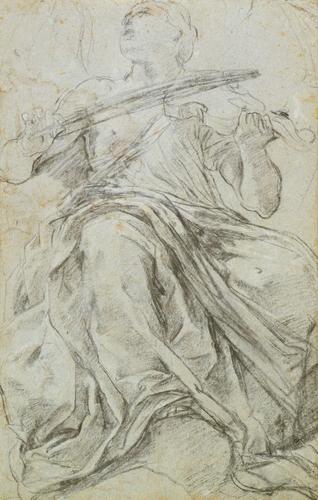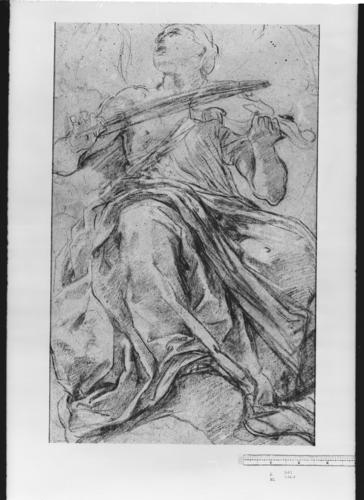An angel with a violin c.1613-15
Black and white chalks on blue paper | 37.8 x 24.0 cm (sheet of paper) | RCIN 903464
-
A drawing of a seated figure playing a viol, seen from below, looking up to the left.
The drawing is a study for an angel in the fresco of St Dominic in Glory, painted by Guido Reni in the semi-dome of the chapel housing the saint’s remains in the church of San Domenico, Bologna. It is close in detail to the figure in the fresco, and though drawn from a model, Reni added the outlines of the angel’s wings in the upper corners of the sheet. The drapery in the fresco is much softer than in the drawing, where the strong faceting seems to have been a result of the hard, scratchy black chalk used for the study.
St Dominic died in Bologna in 1221 and was buried in the Dominican church of San Niccolò delle Vigne in that city. Rebuilding of the church began soon after, and it was rededicated to the saint following his canonisation in 1234. A tomb to house St Dominic’s remains was carved c.1265 by Nicola Pisano, and was moved to the old south transept, converted into the chapel of St Dominic, in 1411. Later that century the lid of the sarcophagus was replaced with an elaborate pitched roof, with standing figures by Niccolò dell’Arca and Michelangelo. The chapel was remodelled between 1597 and 1605, whereupon the Dominicans sought to embellish the new large space.
In January 1610 Reni (then in Rome) received 100 scudi on account for a painting for the chapel, probably intended for the side-walls, and the following month he bought canvas and strainers for that work (or works: one entry in his account book refers to li quadri). In December of that year Reni returned the advance to the Dominicans, a common occurrence as he was in the habit of accepting more work than he could execute. It seems that at about the same time Alessandro Tiarini was commissioned to fresco the semi-dome of the chapel, and two of Tiarini’s compositional studies for the project survive; but Giovanni Luigi Valesio, with powerful supporters, succeeded in having Tiarini’s commission overturned in July 1611. Valesio was reluctantly allowed to execute the fresco, without payment and subject to the proviso that, should it not meet with approval, he would be liable for its removal. In January 1612 Valesio’s work was indeed found to be unsatisfactory, and the project to fresco the semi-dome ground to a halt.
When in 1612 or 1613 Reni returned from Rome to Bologna, having fallen out with his Borghese patrons, his earlier commission must have been cancelled and he was instead assigned the commission for the fresco in the semi-dome (the side paintings were executed by Mastelletta, Tiarini and Leonello Spada in 1613-16). A first payment was made to Reni in October 1613 but work stopped that December, when a plasterer was paid to consolidate (stabilir) the work that Reni had done so far (presumably tidying up the ragged edges of the fresco’s giornate). The artist had been pressured into returning to Rome, where in 1614 he executed the famous Aurora for Scipione Borghese (see RCIN 903460). Even when work on that fresco had just begun, Reni was already thinking of quitting the city; in a letter to Cardinal Maffeo Barberini (later Urban VIII) of 15 February 1614 he wrote of returning to Bologna ‘to finish the work begun in San Domenico’. He left Rome that autumn, resumed work on the fresco, and a final payment was made in June 1615.
Malvasia recorded that on the unveiling of the fresco it was jealously criticised by Ludovico Carracci, Francesco Albani and Tiarini, who claimed that the figures were too large and their draperies too voluminous. Tiarini’s earlier drawings for the same site had featured much smaller figures, and the present drawing hints at the important role that the draperies were to play in Reni’s organisation of the composition. The clarity of the fresco recaptured something of the freshness of the Carracci’s early paintings, effectively rendering Ludovico’s later works irrelevant for the future direction of the Bolognese school, and establishing Reni as the city’s leading painter.
Text adapted from M. Clayton, The Art of Italy in the Royal Collection: Renaissance and Baroque, London 2007, no. 118. See also Guido Reni. Zeichnungen, exh. cat., Albertina, Vienna, 1981, no. 54; S. Pepper, Guido Reni, 1984, under no. 44; Guido Reni und Europa, exh. cat., Frankfurt 1988, no. B28.Provenance
Listed in George III’s Inventory A, c.1800-20: p. 80, ‘Guido &c. Tom. 5’, among ‘9 Studies for Draperies’
-
Creator(s)
-
Medium and techniques
Black and white chalks on blue paper
Measurements
37.8 x 24.0 cm (sheet of paper)
Other number(s)










